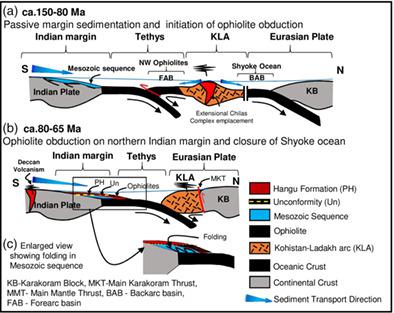当前位置:
X-MOL 学术
›
Geolog. J.
›
论文详情
Our official English website, www.x-mol.net, welcomes your
feedback! (Note: you will need to create a separate account there.)
Integrated provenance and tectonic implications of the Cretaceous–Palaeocene clastic sequence, Changla Gali, Lesser Himalaya, Pakistan
Geological Journal ( IF 1.4 ) Pub Date : 2021-07-05 , DOI: 10.1002/gj.4207 Muhammad Qasim 1, 2, 3, 4 , Jalil Ahmad 3 , Lin Ding 1, 2, 4 , Javed Iqbal Tanoli 3 , Maryam Sattar 5 , Qasim Ur Rehman 6 , Muhammad Awais 7 , Muhammad Umar 6 , Upendra Baral 1, 2 , Hawas Khan 8
Geological Journal ( IF 1.4 ) Pub Date : 2021-07-05 , DOI: 10.1002/gj.4207 Muhammad Qasim 1, 2, 3, 4 , Jalil Ahmad 3 , Lin Ding 1, 2, 4 , Javed Iqbal Tanoli 3 , Maryam Sattar 5 , Qasim Ur Rehman 6 , Muhammad Awais 7 , Muhammad Umar 6 , Upendra Baral 1, 2 , Hawas Khan 8
Affiliation

|
This study documented the field relationship and integrated provenance of a clastic sequence exposed at the Mesozoic–Cenozoic boundary located in Changla Gali section, Lesser Himalaya, Pakistan, to provide an insight into Cretaceous tectonics of the northern Indian margin. This boundary sequence is represented by the Early Palaeocene Hangu Formation, which consists of shales in the lower part and sandstone in the upper part. The contact relationship of the Early Palaeocene Hangu Formation with the underlying Late Cretaceous Kawagarh Formation is marked by an angular unconformity. The detrital zircons extracted from the shale and sandstone samples shows a major age cluster, which varies between ~700 and ~1,100 Ma (45%), ~1,600 and ~1,900 Ma (15%), and ~480 and ~590 Ma. Additionally, two minor age clusters of the detrital zircons are identified, that is, ~2,300–2,500 Ma and ~600–700 Ma. The younger detrital zircon grains have ages of 298 ± 4 Ma, 297 ± 4 Ma and 116 ± 3 Ma. This age pattern reflect the major source area as the Indian Plate. The two younger Permian zircon grains may be derived from the Panjal mafic volcanic rocks exposed in the vicinity of the study area. However, a single Cretaceous grain may be attributed to ophiolites, as well as Tethyan Himalayan (TH) volcanic rocks. Similarly, the sandstone petrographic results show that the sandstones are quartz-rich, which show derivation from the craton interior provenance, which is likely the Indian Plate. However, the trace element data suggest a mixed source consisting of felsic and mafic rocks. The contribution of the mafic source is likely associated with the Panjal mafic rocks exposed along the northern Indian margin. The field relationship shows that the underlying Mesozoic sequence is folded prior to the deposition of the Hangu Formation. This folding suggests that the northern Indian margin experienced a regional compression during the Late Cretaceous time, which folded the Mesozoic sequence before the resumption of sedimentation during the Palaeocene. Furthermore, the detrital zircon provenance suggests that the sediments were mainly derived from the Indian Plate. Combining the results, it can be concluded that the compressional event is likely associated with the Late Cretaceous ophiolite obduction onto the leading edge of the Indian Plate. However, the absence of the major ophiolitic age component in the detrital record may suggest that the ophiolites were emplaced over the northern Indian margin but remained submerged during Early Palaeocene time.
中文翻译:

巴基斯坦小喜马拉雅长拉加利白垩纪-古新世碎屑层序的综合物源和构造意义
本研究记录了位于巴基斯坦小喜马拉雅山昌拉加利剖面的中-新生代边界出露的碎屑层序的现场关系和综合物源,以提供对北印度边缘白垩纪构造的深入了解。该边界层序以早古新世函谷组为代表,其下部为页岩,上部为砂岩。早古新世函谷组与下伏的晚白垩世 Kawagarh 组的接触关系以角度不整合为标志。从页岩和砂岩样品中提取的碎屑锆石显示出一个主要的年龄簇,在~700 到~1,100 Ma(45%)、~1,600 和~1,900 Ma(15%)以及~480 和~590 Ma 之间变化。此外,还确定了碎屑锆石的两个较小年龄簇,即~2,300-2,500 Ma 和~600-700 Ma。较年轻的碎屑锆石年龄分别为 298±4 Ma、297±4 Ma 和 116±3 Ma。这种时代格局反映了印度板块的主要源区。两个较年轻的二叠纪锆石颗粒可能来自研究区附近出露的 Panjal 基性火山岩。然而,单个白垩纪颗粒可能归因于蛇绿岩以及特提斯喜马拉雅 (TH) 火山岩。同样,砂岩岩相学结果显示砂岩富含石英,这表明源自克拉通内部物源,这可能是印度板块。然而,微量元素数据表明由长英质和镁铁质岩石组成的混合来源。基性源的贡献可能与沿印度北部边缘出露的 Panjal 基性岩有关。场关系表明,下伏中生代层序在函谷组沉积之前被折叠。这种褶皱表明印度北部边缘在晚白垩世期间经历了区域压缩,在古新世恢复沉积之前折叠了中生代层序。此外,碎屑锆石物源表明沉积物主要来自印度板块。结合这些结果,可以得出结论,挤压事件很可能与晚白垩世蛇绿岩向印度板块前缘的俯冲有关。然而,碎屑记录中主要蛇绿岩年龄成分的缺失可能表明蛇绿岩位于印度北部边缘,但在早古新世时期仍被淹没。
更新日期:2021-09-02
中文翻译:

巴基斯坦小喜马拉雅长拉加利白垩纪-古新世碎屑层序的综合物源和构造意义
本研究记录了位于巴基斯坦小喜马拉雅山昌拉加利剖面的中-新生代边界出露的碎屑层序的现场关系和综合物源,以提供对北印度边缘白垩纪构造的深入了解。该边界层序以早古新世函谷组为代表,其下部为页岩,上部为砂岩。早古新世函谷组与下伏的晚白垩世 Kawagarh 组的接触关系以角度不整合为标志。从页岩和砂岩样品中提取的碎屑锆石显示出一个主要的年龄簇,在~700 到~1,100 Ma(45%)、~1,600 和~1,900 Ma(15%)以及~480 和~590 Ma 之间变化。此外,还确定了碎屑锆石的两个较小年龄簇,即~2,300-2,500 Ma 和~600-700 Ma。较年轻的碎屑锆石年龄分别为 298±4 Ma、297±4 Ma 和 116±3 Ma。这种时代格局反映了印度板块的主要源区。两个较年轻的二叠纪锆石颗粒可能来自研究区附近出露的 Panjal 基性火山岩。然而,单个白垩纪颗粒可能归因于蛇绿岩以及特提斯喜马拉雅 (TH) 火山岩。同样,砂岩岩相学结果显示砂岩富含石英,这表明源自克拉通内部物源,这可能是印度板块。然而,微量元素数据表明由长英质和镁铁质岩石组成的混合来源。基性源的贡献可能与沿印度北部边缘出露的 Panjal 基性岩有关。场关系表明,下伏中生代层序在函谷组沉积之前被折叠。这种褶皱表明印度北部边缘在晚白垩世期间经历了区域压缩,在古新世恢复沉积之前折叠了中生代层序。此外,碎屑锆石物源表明沉积物主要来自印度板块。结合这些结果,可以得出结论,挤压事件很可能与晚白垩世蛇绿岩向印度板块前缘的俯冲有关。然而,碎屑记录中主要蛇绿岩年龄成分的缺失可能表明蛇绿岩位于印度北部边缘,但在早古新世时期仍被淹没。











































 京公网安备 11010802027423号
京公网安备 11010802027423号